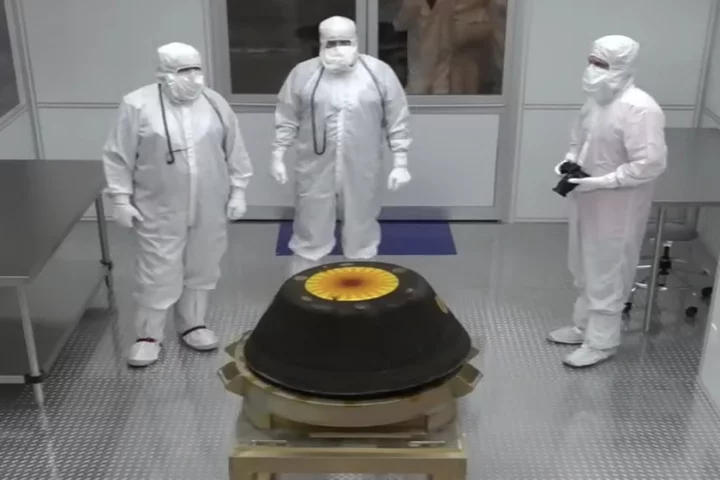
Nasa has gathered a large piece of a distant asteroid. What now?
Scientists have gathered a significant chunk of a distant asteroid, which has made its way to Earth after a mission taking millions of miles. But the really useful work will begin now. Nasa’s Osiris-Rex mission flew to the distant Asteroid Bennu, scooped up a piece of the object into a canister, and then flew back to Earth to drop it off. On Sunday, Nasa picked up that canister in the Utah desert and is now working to secure it. It will then send those samples to a variety of scientists around the world, with a chunk of it being sent to more than 200 people at 38 different institutions across the world. They hope that they can use them as a “time capsule” to peer into the early universe, telling us about where we came from. “This box when it is opened of material from the surface of Bennu can tell us untold secrets of the origins of the universe, the origins of our planet and the origins of life itself,” said Queen musician Brian May, who helped with the research by mapping out the asteroid to find a landing spot. “What an incredibly exciting day.” Sample return missions are particularly exciting to scientists because they offer a look at a pristine piece of a distant world that has been undisturbed by the environment on Earth. While some pieces of asteroids and other objects can fall down to Earth, they have to make their way through the atmosphere and can be damaged and changed in the process. They also mean that researchers are able to use all of the Earth’s latest technology to study the sample. Other pieces of distant worlds have of course been studied by spacecraft and landers, but they are only able to do so with the limited instruments they take to those planets. Another advantage of sample return missions over studying the objects at their home is that scientists can look back at those samples with new sensors and equipment invented long after the sample was actually taken. Many space missions continue for years – Curiosity is still examining Mars after arriving there in 2012, and the Voyager probes are still providing information almost 50 years after they were launched – but they are only able to do so with the technology that was available when they set off. The analysis done in sample return missions really begins when the spacecraft arrives at its target: then, it starts looking at the context of the sample, gathering information about the world from which it came that should prove useful to scientists later. Osiris-Rex arrived at Bennu in 2018, and spent two years mapping the asteroid before it set off back home with its delivery. All of that information in addition to the samples could help answer a variety of questions about our planet, scientists hope. “The asteroids in our solar system contain the raw building blocks from which the Earth was made, so working out their composition will tell us a lot of how our planet formed,” said Boris Gansicke from the department of physics at the University of Warwick. “There are many open questions, for instance, where did the water that we have on Earth come from? And where did the ingredients that made life possible to develop come from? “To answer those questions, ie measure the composition of an asteroid, you need to get your ‘hands’ on them (or in this case the arm of a space mission), and this is what Osiris-Rex achieved. “In a nutshell, it’s similar to sitting in front of a delicious dinner and wanting to have the list of ingredients.” Sample return missions are almost as old as space travel itself, and the first of them were the early Apollo missions, which brought back pieces of the Moon. Those continue to be useful to scientists. Since then, as human travel into space has declined, most of the work has been done by robots. In the early 1970s, the Soviet Union’s Luna missions gathered pieces of the Moon and brought them back, and in 2020 Japan’s Hayabusa2 mission brought back pieces of the asteroid Ryugu. Scientists have high hopes for future missions: perhaps the most discussed is a mission to Mars, which would bring back the first ever pieces of that planet. Engineers have suggested that for decades, and a number of plans have been formed, but none are likely to launch any time soon. Read More Nasa spots shocking number of galaxies like our own Nasa lands Bennu asteroid samples back on Earth Nasa just delivered a piece of a distant asteroid to Earth Pieces of a distant asteroid are about to fall to Earth Nasa to return largest asteroid sample ever as UK helps with research Massive solar flare strikes Nasa spacecraft sent to study Sun
2023-09-26 00:45

FTC Fines Microsoft $20 Million for Illegally Collecting Children's Data
The FTC fined Microsoft $20 million for illegally collecting and retaining the data of children
2023-06-06 18:46

Teenager hospitalised after USB cable gets stuck inside his penis
A teenage boy was sent to a hospital with an unusual problem - a USB cable was stuck inside his penis. The incident, which was first documented in a urology case report in Science Direct in November 2021, apparently saw the 15-year-old arrive at the hospital as he had apparently been trying to use the cable to measure the inside of his penis. However, the cable had become tangled and knotted while it was inside of him causing him to lose blood through his urine. In the report, the doctors wrote: "The two distal ports of the USB wire were found to be protruding from the external urethral meatus whilst the middle part of the knotted wire remained within the urethra. The patient was an otherwise fit and healthy adolescent with no history of mental health disorders." Sign up to our new free Indy100 weekly newsletter The teenager who is from the UK had been taken to the medical facility by his mother and confessed to the medical experts when she was out of the room that he had used a cable instead of a ruler as a means of 'sexual experimentation'. An attempt to fish the cable out using a metal rod proved unsuccessful to the amount of knotting that had occurred, forcing the team to do surgery on the boy in order to retrieve the cable. They did this by cutting open the section between the genitalia and the anus so they could access the area where the cable was stuck. In the report, the doctors explain the procedure as follows: "A longitudinal peno-scrotal incision over the palpable foreign body was made and careful dissection was undertaken through deeper tissues, splitting the bulbospongiosus muscle. Both ends of the wire were pulled out successfully through the external urethral meatus." They add: "Both ends of the wire were pulled out successfully through the external urethral meatus." Thankfully the young man recovered well from the surgery and was discharged shortly afterwards. In their notes, the urology doctors admit that although cases like this are not out of the ordinary, particular cases like this are considered to be unusual. They state: "Sexual experimentation and gratification, as well as underlying mental disorders, are considered the main causes of retained foreign bodies in the urethra and bladder. Management varies depending on the shape and size of the object, and the mechanism of insertion." Have your say in our news democracy. Click the upvote icon at the top of the page to help raise this article through the indy100 rankings.
2023-08-01 20:48

Get a pack of two Apple Watch keychain chargers for $39
TL;DR: As of July 30, get this Apple Watch wireless charger keychain for just $38.99
2023-07-30 17:53

Cognizant's $570 million trade-secret case win against Syntel thrown out on appeal
By Blake Brittain A U.S. appeals court on Thursday vacated a $570 million award Cognizant Technology Solutions Corp
2023-05-26 18:46

Threads improvements are coming - and its first could be a 'hilarious' dig at Elon Musk
It’s been less than a week since Instagram launched Threads, its text-based alternative to Twitter, and the team at Mark Zuckerberg’s Meta are already looking to rollout new features to improve the app – one of which could be a “hilarious” jab at Twitter owner Elon Musk if it’s implemented the right way. Released just days after the bird app was marred by outages and temporary limits on the number of tweets users could view a day, Threads has already been criticised for its lack of a Following feed (it’s currently algorithmically generated) and the absence of an alt text feature for blind and visually impaired users – amongst other issues. Now, Instagram boss Adam Mosseri has confirmed his team are looking to introduce new – and much-requested – features to the app. In a post on Threads on Tuesday, he wrote: “With so many people joining [Threads] so fast these last six days (six days!) the team has been entirely focused on keeping the lights on and fixing bugs. “But we’re starting to [prioritise] the obvious missing features, like a following feed, the edit button, and post search. “We’re clearly way out over our skis on this, but the team is pumped to start shipping improvements this week.” Sign up to our free Indy100 weekly newsletter However, it’s one reply to Mosseri’s post which has got users all excited at the possibility for some delicious “schadenfreude”. Writer and photographer Craig Mod suggested: “It would be hilarious if the first thing you ship is a free edit button.” Hilarious because over on Twitter, the feature is paywalled behind a subscription to Twitter Blue – the same £11 a month offer which affords users the once-coveted blue checkmark, but also the ability to upload videos up to two hours’ long, and post tweets up to 25,000 characters in length. That’s five times the character limit on Threads, just to put that into perspective. And so, the idea of Instagram embarrassing Musk once more (in addition to the 100 million users the app boasts already in six days alone) with a free edit feature has amused many other individuals who flocked to Threads from Twitter. “This idea is giving me chaotic energy and I’m here for it,” commented one. Another claimed: “This would destroy bird app [sic].” “The one thing Twitter would NOT give us for free. Yep. That is where I would start.” Not just that, but Mosseri himself has liked Mod’s tweet. So now we wait… Have your say in our news democracy. Click the upvote icon at the top of the page to help raise this article through the indy100 rankings.
2023-07-11 22:46

SoundHound AI Launches Fully Automated Smart Answering Service That Lets Any Business Handle Customer Service Calls With Voice AI
SANTA CLARA, Calif.--(BUSINESS WIRE)--Aug 10, 2023--
2023-08-10 21:18

Conspiracy theories insist new Tiffany Gomas apology video isn't her
Conspiracy theories have taken over the internet since the "not real" American Airlines passenger, Tiffany Gomas, released an apology video in which she addresses the incident from 2 July. To recap, the 38-year-old marketing executive from Texas went viral for her rant on board, where she claimed a fellow passenger wasn't real. "That mother f**ker back there is not real," she said at the front of the plane while pointing towards her seat, which has since gone on to become an online phenomenon with TikTok trends, merch – and conspiracies. On Sunday (14 August), Gomas finally addressed the incident with a self-recorded video posted to her X account (formerly known as Twitter). And some conspiracy theorists online insist it's not really her. One person wrote, "Who actually believes that this is the crazy plane lady Tiffany Gomas speaking out? Who TF they trying to kid?" – though, he didn't clarify who "they" was. Another person made the claim: "Not only is this not the same person but someone ran a traceroute on her website, tiffanygomas(dot)ćom, and it runs through a Washington DC email. Her IP isn't your standard home internet IP address, mostly likely ran through a government server. This was government created." Meanwhile, a third wrote: "The mystery of whether this is really the person she claims to be can be easily solved if she produces a record of her flight receipt. Just as the lady on the plane did not believe that guy was real- I’m skeptical that this is the real person." Sign up for our free Indy100 weekly newsletter In the clip, Gomas apologised for her language, before saying: "We all have our bad moments, um, some are far worse than others, and mine happened to be caught on camera for the whole world to see multiple times." She continued: "Sorry y’all. I hope that I can use this experience and do a little good in the world, and that is what I intend to do, I hope that you guys can accept my apology and I can begin to move on with my life." Gomas did not address her "not real" comment on the flight. One Twitter user hilariously hit back with the question on everyone's mind: "So was that motherf***er real, or no?" Have your say in our news democracy. Click the upvote icon at the top of the page to help raise this article through the indy100 rankings.
2023-08-15 17:26

Global investors skip Ant’s buyback after valuation slumps 70% - Bloomberg News
(Removes repetition of CPPIB in paragraph 6) (Reuters) -A number of global investors are opting out of Ant Group's proposed
2023-08-08 11:58

Boost productivity with this dual screen monitor, now $100 off
TL;DR: As of July 9, get The Geminos Stacked Dual 24" Screen Monitor for only
2023-07-09 17:56

Best Black Friday 2023 Deals for Nintendo Switch Owners
Save big with these Black Friday deals on Nintendo Switch products.
2023-11-09 03:23

This $20 course bundle shows you how to use Excel like a pro
TL;DR: Through Aug. 13, you can sign up for the 2023 Ultimate Microsoft Excel Training
2023-08-02 17:52
You Might Like...

Riot Games Partners With Coca-Cola to Launch League of Legends Inspired Drink

When do Futurama Skins Leave Fortnite?

Kivera Welcomes Joe Lea as CEO

Twitter finally adds secure messaging to DMs – but Elon Musk tells people not to ‘trust it’

New York City unveils an 'artificial intelligence action plan'

South Africa to Require Crypto Exchanges Licensing by Year-End

Origin’s Top Investor to Reject Brookfield’s A$19 Billion Bid

Meta Stock at Cusp of Hitting Levels Seen Before Historic Crash
